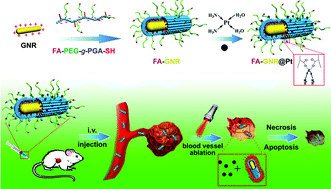
Gold nanorods with cisplatin-polypeptide wrapping were developed for combinational photothermal therapy and chemotherapy of triple negative breast cancer.
Researchers from China have advanced the fight against breast cancer (BC) by developing a method that targets triple negative breast cancer (TNBC) – a highly aggressive subtype of BC and a form that is challenging to completely eradicate.
Their method consisted of the formation of gold nanorods (GNRs) with a cisplatin-polypeptide wrapping and folic acid (FA) functionalization (FA-GNR@Pt) for the simultaneous targeted photothermal therapy and chemotherapy.These hybrid nanoparticles combine the photothermal conversion properties of GNRs,superior biocompatibility of polypeptide poly(L-glutamic acid) (PGA),chemotoxicity of cisplatin and the tumour targeting ability of FA. FA-GNR@Pt nanoparticles exhibited temperature increases bothin vitroandin vivousing 655 nm NIR laser irradiation and,in combination with systemic administration in mice,were able to inhibit the proliferation and lung metastisis of the 4T1 breast tumour.
The research presented here takes significant steps in furthering the understanding of breast cancer,particularly TNBC,which have increased risk of metastisis.
Near infrared light-actuated gold nanorods with cisplatin–polypeptide wrapping for targeted therapy of triple negative breast cancer
Bing Feng,Zhiai Xu,Fangyuan Zhou,Haijun Yu,Qianqian Sun,Dangge Wang,Zhaohui Tang,Haiyang Yu,Qi Yin,Zhiwen Zhang and Yaping Li
Nanoscale,2015,7,14854-14864. DOI: 10.1039/C5NR03693C
Dr Lee Barrett is a guest web writer for the Nanoscale blog.Lee is currently a postdoctoral researcher in the Centre for Molecular Nanometrology at the University of Strathclyde.His research is currently focused on the development of nanoparticle-based sensors and surface enhanced Raman scattering (SERS).Follow him on twitter@L_Bargie.



















